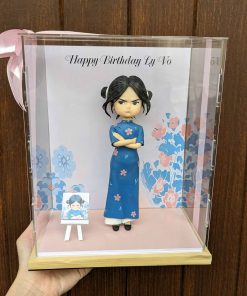❤️ symbolic price 22.6 ❤️
Liên hệ
- Cam kết sản phẩm đúng như trong mô tả
- Chất lượng và độ bền sản phẩm cao nhất
- Mức giá cạnh tranh nhất
- Giao hàng nhanh chóng toàn quốc
- Tư vấn nhiệt tình, giải đáp mọi thắc mắc của khách hàng

Tượng chibi 3D làm theo yêu cầu:
– Bảng giá: Xem tại đây
– Báo chí nói về Tượng Chibi Tamy:
* HTV7: https://bit.ly/3DPN3Sn
* Báo dân trí: https://bit.ly/3MC5i1r
* Báo vnexpress: https://bit.ly/3VwlLZ7
* Báo công luận: https://bit.ly/3ezJhnv
*Báo thanh niên: https://bit.ly/3SmEunh
* Báo tuổi trẻ: https://bit.ly/3CSlDLb
* Báo 24h.com: https://bit.ly/3f0YEpu
* kênh ytb talkshow: https://bit.ly/3Tn33Sz
* VTC: https://bit.ly/3TPCzcg
– Thời gian: Từ 2 ngày đến 10 ngày , tùy số lượng (tùy sản phẩm).
– Chất liệu tượng: Đất sét tạo hình, không độc hại, khô cứng và dẻo, bền màu theo năm tháng.
– Độ bền sản phẩm: Trên 10 năm.
– Loại tượng: Có 3 loại ( Chibi – Doll tả thực – Điêu khắc truyền thần).
– Kích thước của tượng: 10cm đến 20cm – tính chiều cao tượng từ đầu đến chân.
– Phụ kiện: Ảnh nền, hộp mica, chụp thủy tinh, nhựa giả gỗ,v.v
– Dựng cảnh: Nếu có yêu cầu.
– Bảo hành : Một lần trọn đời.
– Quy cách đóng gói : Thùng carton, mốp xốp, chống va đập, đảm bảo hàng nguyên vẹn đến tay khách hàng.
– Giao hàng : HCM + Toàn Quốc + Các nước khác.
– Zalo :
Mr Đức 0783893888
Miss Như: 0898678587
-Địa chỉ : 63/8 Trần Văn Ơn , Tân Sơn Nhì , Tân Phú , HCM
- Website:
http://quasinhnhat888.com/
http://tuongchibi.com/
https://www.facebook.com/tuongchibitamy
Introduction: Symbolic price is a concept that has been used throughout history to represent more than just a monetary value. Whether it be a small gift given as a token of appreciation or a price set intentionally low to convey a message, symbolic pricing can carry significant meaning and symbolism. Understanding the power of symbolic pricing can deepen the connection between a buyer and seller and add value beyond the physical product or service being exchanged.
Body: Symbolic pricing can take many forms. One common example is the act of setting a price deliberately low to signify the seller’s humility or generosity. This could be seen in the traditional practice of haggling at a marketplace, where both parties engage in a negotiation that goes beyond just the monetary exchange. By offering a discount or lowering the price, the seller is signaling their willingness to compromise and reach a mutually beneficial agreement. On the other hand, symbolic pricing can also be used to convey exclusivity or prestige. Luxury brands often set their prices at a premium to signal to consumers that their products are of superior quality and status. By pricing their goods higher than their competitors, these brands project an image of luxury and sophistication that appeals to a certain demographic. In this way, price becomes a symbol of social status, identity, and aspiration.
Beyond monetary value, symbolic pricing can also be used to communicate cultural or emotional significance. In some cultures, it is customary to exchange gifts with symbolic prices attached to them. For example, in Japanese culture, it is common to give gifts with specific price points that correspond to certain occasions or relationships. The price of the gift is carefully considered to convey the giver’s intentions and feelings, making the act of gift-giving more than just a transaction. Additionally, symbolic pricing can be used to signal appreciation or gratitude. By offering a product or service at a lower price than its true value, the seller is acknowledging the buyer’s loyalty or support. This can create a sense of reciprocity and goodwill that strengthens the relationship between the two parties.
In conclusion, symbolic pricing goes beyond the simple exchange of goods and money. It is a powerful tool that can be used to convey a wide range of meanings and emotions. Whether it is used to signal humility, exclusivity, cultural significance, or gratitude, symbolic pricing adds depth and significance to the transaction. By understanding the power of symbolic pricing, both buyers and sellers can enhance their interactions and create a more meaningful exchange.












